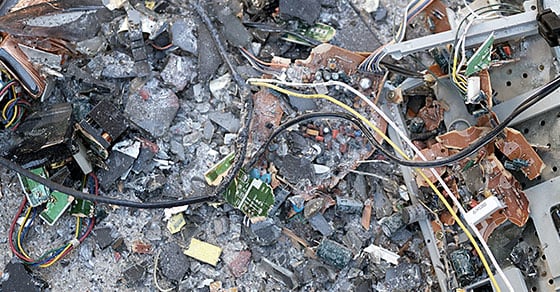Electronic waste, or e-waste, encompasses everything from old cellphones, to VCR’s, fax machines, TV’s, and everything in between.
As the world and its inhabitants become increasingly dependent on technology, levels of electronic waste are reaching unprecedented heights, with the world in desperate need of a sustainable management solution for this rapidly growing category of waste.
What’s Causing the Surge in E-Waste?
While electronic waste is nothing new, a number of issues are causing it to become an issue increasingly on the forefront of sustainability efforts.
With nearly each passing day, technology becomes more and more integrated into our daily lives; homes can now be equipped with smart systems; our mobile devices serve as our cameras, calendars, and access to entertainment; our TV’s now connect us with our favorite streaming shows. The world of technology has changed drastically over the last few decades, resulting in a constant flow of new and better versions of our much-loved electronic goods.
And while this has made our lives and the way we communicate more convenient and more advanced than ever, it also adds up to increased consumption.
Also in part to blame is the shorter lifespans and planned obsolescence of our gadgets. Companies produce products with changes in the design, or updated software, rendering “old” versions as outdated, obsolete, or no longer supported. The world has become conditioned to get the latest and greatest device, kicking our old ones to the curb with hardly a second thought. In 2012, only 29% of the 3,420,000 tons of the e-waste generated was recycled.
Problems Surrounding E-Waste
Growing sources of e-waste present a number of considerable problems:
Increases the Need to Mine Finite Resources
Cellphones, computers, and other technological products contain a number of valuable materials that must be mined. Rare earths, gold, palladium, copper, and more all reside within our cell phones, TVs, and more.
These valuable materials are acquired through intensive mining operations. The recycling of such materials from our old gadgets would allow us to reuse these valuable materials, ultimately requiring less mining and conserving our finite resources.
According to the EPA, the recycling of one million cell phones yields 35,000 lbs. of copper, 772 lbs. of silver, 75 lbs. of gold, and 33 lbs. of palladium. DoSomething.org claims that over $60 million in gold and silver in the form of phones is dumped by Americans annually.
Encourages Hazardous Working Conditions
Despite efforts to thwart such practices, many of our outdated electronics end up in developing nations, where legislation around e-waste is lax or even non-existent. Here, workers sort through the products by hand or use crude processing methods to recover the desired components – a highly toxic endeavor.
A recent study by the Basel Action Network (BAN), in which GPS trackers were put on items of e-waste and then donated or brought to recycling centers, found that 40% of the items delivered to US recyclers were exported, 93% of which went to developing countries.
Endangers the Environment
The toxic components in e-waste not only pose risks to workers in developing nations, but they also pose risks to the environment; where e-waste is either improperly handled or disposed of, there is risk of soil and groundwater contamination.
Mercury, lead, cadmium, and other components have the potential to seep into soil and groundwater, contaminating these valuable resources.
Solutions on the Horizon
It’s easy to see why e-waste is quickly becoming a topic of discussion around sustainability. More than ever, a solution to these growing mountains of e-waste is needed. Many have pinpointed improved legislation, advancement in recycling technologies, increased education, and more convenient recycling programs for resolving the electronic waste crisis. Some companies have already jumped on the bandwagon toward finding improved recycling methods.
The Washington-based company behind Redbox and Coinstar has developed a line of ecoATM kiosks, where consumers can conveniently sell their old phones for cash on the spot where they already shop. The company then refurbishes what it can, and ensures the rest is recycled in a sustainable way.
Many organizations have been formed to promote increased awareness and advocate for the changes needed to solve the issues surrounding e-waste. For example, the US EPA collaborates with the United Nations University – Solving the E-waste Problem Initiative (StEP), to address e-waste on a global level. Similarly, the International E-Waste Management Network (IEMN) brings together officials from all over the world to collaborate on e-waste.
FEECO has worked with companies to recover precious metals from electronics such as circuit boards and batteries through high temperature thermal processing in rotary kilns.
Conclusion
As we become increasingly integrated with technology and the latest electronics, e-waste will continue to become a growing concern for the earth and its inhabitants.
FEECO has long been an environmental steward, involved in the transformation of waste materials into value-added products, including metal recovery from e-waste. Our state-of-the-art Innovation Center allows us to run batch and continuous tests on your material and intended process. We then use the data gathered during testing to engineer the custom equipment you need. For more information on our e-waste processing capabilities, contact us today!
Image Source: takomabibelot, E-Waste in the Alley (Silver Spring, MD), Cropped by FEECO International, CC BY 2.0



